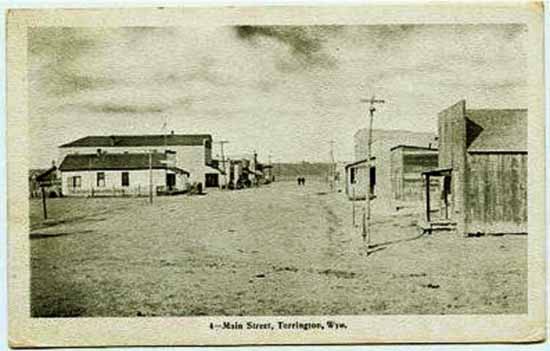
Torrington, undated, photo by Hiram W."Hi" Yoder
Torrington was founded
by William G. Curtis (1857-1913) in 1889, who named it after his hometown in Connecticut. Curtis was
also the first postmaster, maintaining the post office at his homestead. Mail was delivered from Cheyenne to Fort Laramie
by stage and then carried to Torrington twice a week. After incorpoation of the town, Curtis sered as mayor twice.
The Burlington began passenger service in May 1900, with George King serving as
station agent.
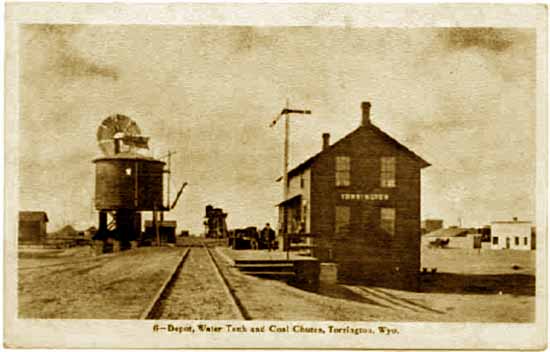
Burlington Depot, 1908. Photo by Hiram W. Yoder.
By the time of the above photo, the town had a national bank, three general stores, two hotels, and a pharmacy.
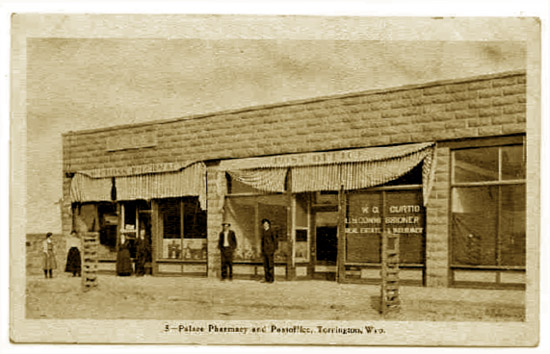
Palace Pharmacy and Curtis Land Office and Post Office. Photo by Hiram W. Yoder.
The awning over the pharmacy refers to it as the "Red Cross Pharmacy, while the caption on the
postcard refers to its as the "Palace Pharmacy." Neither is in error. The pharmacy was established in 1906
as the Red Cross Pharmacy by W. S. Miller and E. S. Empey. The following year, the pharmacy was
was sold to Hi Yoder (1864-1925) who changed the name to the Palace. Like many drug stores of the age, it
featured a full soda fountain. Next door was the post office and land office operated by W. G. Curtis. Before establishment
of the land office, those wishing to claim property as homestead or under the Desert Land Act had to
travel to Cheyenne.
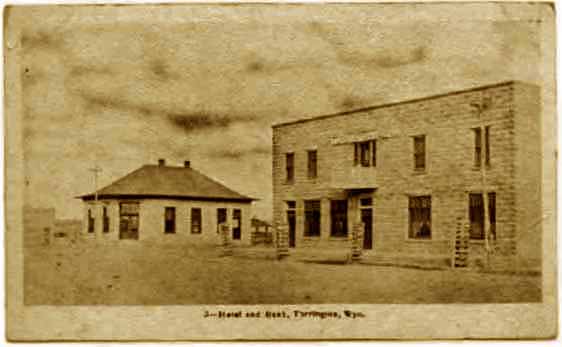
Torrington Hotel, 1908. Photo by Hiram W. Yoder.
The hotel, at 1841 Main Street, was constructed in 1906 and operated by E. A. Belingar. The building
is (as of October 2006) still in existence, although as indicated by the 1957 photo below, much modified.
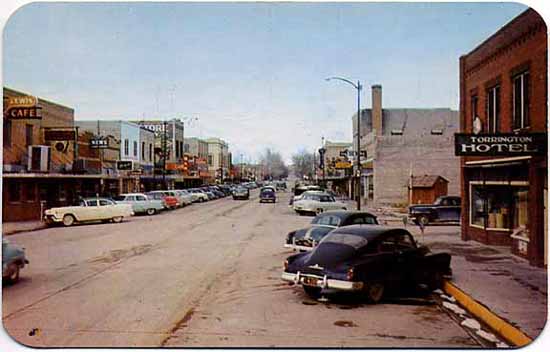
Torrington Hotel, 1957.
The town continued to grow. By 1910, torrington had achieved a population of 155. The newspaper The Torrington Telegraph was established in 1911. The same year, Goshen County was
organized. In a bitter election, Torrington was established as the county seat. Goshen county takes its name from Goshen Hole, which in turn took its
name from Goche's or Goshe's Hole. Some dispute exists as to the origin of the name. Some believe that
the name came from a French trapper. It appears more likely, however, that the name came from that of
a Ree Indian. Early trapper
John C. Luttig, Clerk of the Missouri Company reported in his the Journal of a Fur-trading Expedition on the
Upper Missouri, 1812-1813 edited by Stella Drumm, Missouri Historical Society, 1920:
Monday the 3 at 2 A.M. a Canoe with Garrow, the Interpreter, 2 Engagees
and Goshe a Ree Chief came to us, they brought some Corn and a Letter
from Immel at noon passing along a Bottom, we found a Mocassin tied to a
tree in which we also found a Letter from Immel informing us they were well
and would be at the Rees from thence in One Day. Distance 21 Miles, Killed
5 Deer.
[Writer's notes: But see Proceedings and Collections of
the Wyoming State Historical Department, 1921-1923, p. 99-100, in which John Hunton writes that
he was told by Seth Ward that Goshen was named after the biblical land. Garrow was reported by the Lewis
and Clark expedition as being a Frenchman living an Indian Village in 1804. In
1812, he was reported as being an interpreter at Ft. Manuel Lisa, about 10 miles upstream from
present day Omaha. The Ree Indians, also known as the Arikara. Yet another reputed account has the County's and the Hole's name coming from the
name of a Union Cattle Co. cowboy Goshen Hale. See Downing, C. O. "Recollections of a Goshen County Homesteader," ed. Sharon Reed
Smith, 43 Annals of Wyoming, Spring 1971, p. 53 at p. 68.]
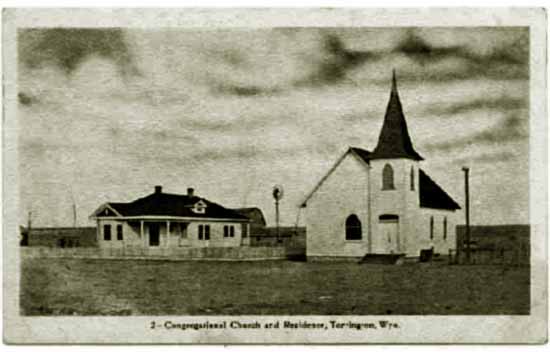
Congregational Church, 1908. Photo by H. W. Yoder.
Other early churches included the Presbyterian church first constructed in 1906. The church
burned down the following year but was rebuilt in 1909. The first Roman Catholic service was conducted by the
Reverend James A. Duffy from Cheyenne in the Congregational Church. Later Catholic services were conducted in
Snow Hall upstairs over John T. Snow's bank. Snow Hall was also used for dances and other
community meetings. Property was purchased in 1921 for the Baptist Church, but for several years all
that could be constructed was the basement in which the congregation met.
In 1913, the cornerstone for the new courthouse was set. At the ceremony Hi Yoder conducted the band.
By that time, the first motor cars had arrived. The first cars were owned by Dr. C. H.
Platz, John T. Snow, , and by Jo Amery. That year, J. P. Nolan, owner of a local
garage, ran an advertisment in the Telegraph advising persons not to "ruin" the automobiles in
his garage by striking matches on the paint. In the same year, the county Fair Association was
formed. By 1915, the town had achieved a population of 443.
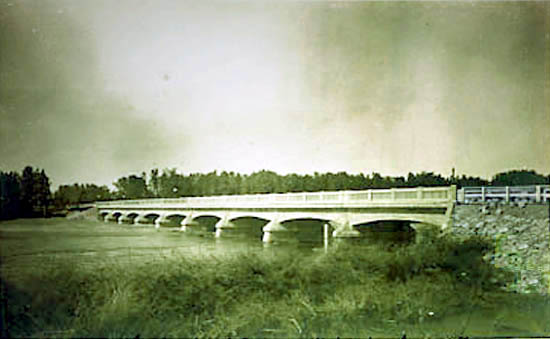
Bridge over the North Platte River, Torrington, 1924
The bridge depicted replaced an earlier bridge constructed in 1905. Prior to the 1905, it was necessary to
ford the river. In the 1920's, the recession which swept the country began to be felt in Torrington. In
1924 the First National Bank failed. The doldrums were short-lived, however, in 1925, the Union Pacific
Railroad constructed a spur line to serve the proposed Holly Sugar Corporation plant which opened in 1926.
The sugar company had been established in in 1905 in Holly, Colorado. The plant has remained the
major employer in Torrington ever since.
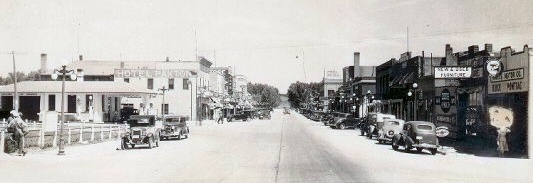
Torrington, 1930's
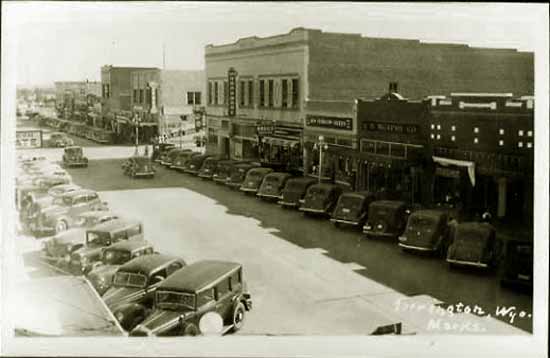
Torrington, approx. 1939.
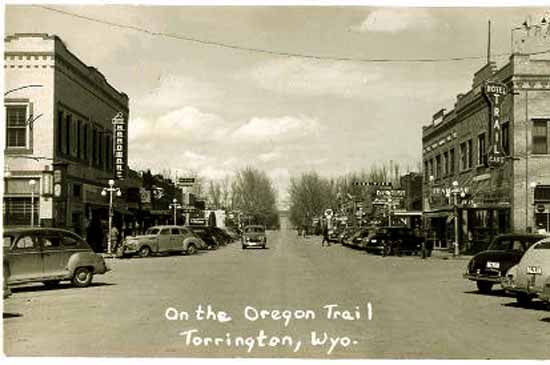
Torrington, approx. 1949.
The Trail Hotel, on the right in the above photo, at 2001 Main Street, was constructed in
1919.
Next Page: Wheatland, Laramie Peak.
|